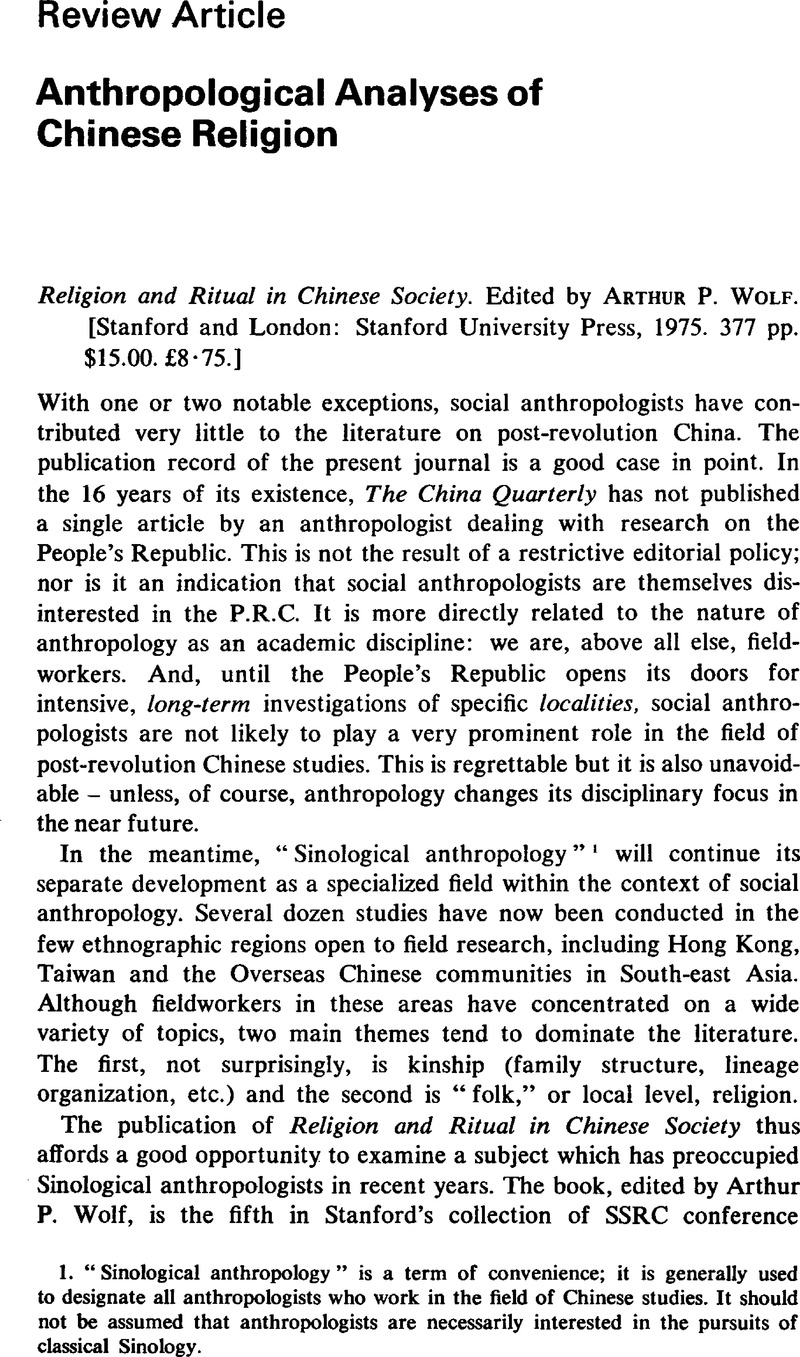Published online by Cambridge University Press: 17 February 2009

1. “Sinological anthropology” is a term of convenience; it is generally used to designate all anthropologists who work in the field of Chinese studies. It should not be assumed that anthropologists are necessarily interested in the pursuits of classical Sinology.
2. The American anthropologist, Robert Redfield, argued that peasant societies were characterized by two separate cultural traditions: the “Great Tradition”of the urban elite and the “Little Tradition”of the peasant masses. According to Redfield and his followers, this dichotomy is reflected in the religious system, with the peasantry lagging far behind the educated elite in terms of theological sophistication. See his Peasant Society and Culture(Chicago: University of Chicago Press, 1956)Google Scholar or his important article, “The social organization of tradition,” Far Eastern Quarterly, Vol. 15, No. 1 (November 1955), pp. 13–21.CrossRefGoogle Scholar
3. (Berkeley: University of California Press, 1967).
4. Review in Journal of Asian Studies, Vol. 21, No. 4 (1962).Google Scholar
5. Groot, J. J. M. De, The Religious System of China(Leiden, 1892–1910), Vols. I–VI.Google Scholar
6. Granet, Marcel, The Religion of the Chinese People (Oxford: Basil Blackwell, 1975).Google ScholarSee also Wolf's, Arthur review of same in Times Literary Supplement No. 3861 (12 March 1976), pp. 285–86.Google Scholar
7. See e.g. Freedman, Maurice, “Geomancy,” Proceedings of the Royal Anthropological Institute (London, 1968), pp. 5–15;Google Scholar and his Chinese Lineage and Society: Fukien and Kwangtung (London: Athlone, 1966).Google Scholar For other views on geomancy, see Ahern, Emily M., The Cult of the Dead in a Chinese Village (Stanford: Stanford University Press, 1973);Google Scholar and Potter, Jack M., “Wind, water, bones and souls: the religious world of the Cantonese peasant,” Journal of Oriental Studies, Vol. 3, No. 1 (January 1970), pp. 139–53.Google Scholar
8. (Vientiane: Editions Vithagna, 1974).
9. I base this statement on field observations in San Tin and, for Sheung Shui, personal communication with Hugh Baker. (Female shamans exist in San Tin, but not the mass seance.)
10. Eugene N. Anderson, The Floating World of Castle Peak Bay(American Anthropological Association, Anthropological Studies, No. 4) (published on demand by University Microfilms, 1970), pp. 156–59. On wu shih, see also DeGroot, The Religious System in China, Vol. 6, p. 1243 et seq.
11. For material on ethnic boundaries, see Barth, Fredrik (ed.), Ethnic Groups and Boundaries (Boston: Little, Brown, 1969).Google Scholar
12. Abner Cohen, an anthropologist who specializes in West African societies, has written a number of things which are directly relevant to the analysis of Chinese ethnicity. See his books, Custom and Politics in Urban Africa (London: Routledge & Kegan Paul, 1969)Google Scholar and Two Dimensional Man: An Essay on the Anthropology of Power and Symbolism in Complex Society (London: Routledge & Kegan Paul, 1974);Google Scholar also his “Introduction: the lesson of ethnicity,” in Cohen, A. (ed.), Urban Ethnicity (London: Tavistock, 1974).Google ScholarPubMed
13. On Chao Chou spirit medium cults, see Elliott, Alan J. A., Chinese Spirit Medium Cults in Singapore (London: Athlone, 1955);Google Scholar and for cults in Hong Kong, see Johnson, Graham E., “From rural committee to spirit medium cult:voluntary associations in the development of a Chinese town,” Contributions to Asian Studies, Vol. 1 (January 1971), pp. 123–43.Google Scholar
14. Abner Cohen, in Custom and Politics in Urban Africa, illustrates how the Hausa traders in West Africa use and manipulate the bonds of ethnicity to monopolize long–distance trade. In essence, Hausa traders only trust other Hausa who are members of the same religious sect. A similar pattern of ethnic exclusiveness seems to operate in certain Hong Kong merchant circles. For instance, the distribution and sale of rice in the New Territories is largely controlled by Chao Chou. The other ethnic groups have found it very difficult to break into this trade. Membership in the Chao Chou cults helps define who is trustworthy and is therefore essential for acceptance in the rice business.
15. “Religious organization in the history of a Taiwanese town,” in Wolf,Religion and Ritual
16. Jordan, David K., Gods, Ghosts, and Ancestors: The Folk Religion of a Taiwanese Village (Berkeley: University of California Press, 1972).Google Scholar On possession and shamanism, see also Diamond, Norma, K'un Shen: A Taiwan Village (NewYork: Holt, Rinehart and Winston, 1969);Google ScholarGallin, Bernard, Hsin Hsing, Taiwan: A Chinese Village in Change (Berkeley: University of California Press, 1966); and De Groot, The Religious System in China, Vol. 6, Chap. 3.Google Scholar
17. Feuchtwang expands on this point in his essay “Investigating religion,” in Bloch, Maurice (ed.), Marxist Analyss and Social Anthropology (London: Malaby Press, 1975).Google Scholar
18. Asian Folklore and Social Life Monographs (Taipei: Orient Cultural Service), Vol. 64.